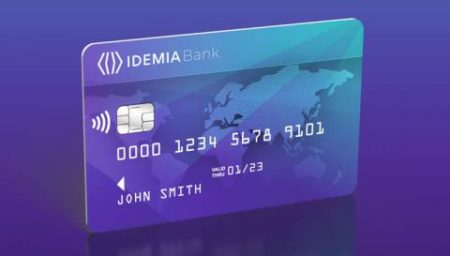Securing daily payments with international and domestic scheme certified products

When blended together, the physical and digital features create one integrated customer experience.
Today, customers trust the physical payment card; they are familiar with it and know that it will work every time and everywhere. But, technology is clearing a path for real time and interactive smartphone features. When blended together, the physical and digital features create one integrated customer experience. For example, cardholders can place a temporary hold on a card, report a card as lost or stolen, order a replacement card, set spending limits for the card and retrieve the card’s PIN code with just a few taps in an app. But before we dive into these examples, let’s examine why payment cards remain front and center in the payment ecosystem in an increasingly digital era.
In the wake of the digital transformation, traditional “physical touch-points” (visits to bank branches, mailed monthly paper account statements) have declined or have disappeared altogether, leaving the payment card as arguably the last tangible link between a bank and its customers. The card is one of the most visible parts of a bank’s brand. Each time cardholders pull out their bank card is a marketing and branding moment. The customer is reminded of the bank and the “mental awareness” of the bank’s brand is reinforced.
Social media is flooded with photos of consumers posing with their payment cards. These cardholders don’t see cards as merely a means to pay, but rather as an extension of themselves. They see payment cards as accessories that align with their lifestyle and values and project a certain image. And in our social media saturated world, we project these images more than ever before. Some card issuers have found ways to leverage this phenomena—notably Walrus. As the company’s Co-Founder and CEO, Bhagaban Behera, explains: “we believe that every teenager is unique and has unique aspirations, and therefore it’s important to give them a card which they can personalize to their identity. Walrus Signature Card is an effort from Walrus to make Gen-Z smart with money in a cool way”1. Walrus invites their cardholders to customize their signature, which later is printed on the card, transforming it into a unique extension of each individual customer.
Given the incredible branding opportunity that payment cards create, major players such as Apple, Tencent, Amazon, Revolut and Monzo are not only launching their own payment cards, they are truly leading the way with cards made out of innovative materials with groundbreaking designs. Numerous mobile-centric challenger banks have proved that metal cards are an incredibly efficient asset when establishing and building their novel brands—particularly with the growing Millennial segment. Also, more and more non-traditional bank players are launching physical cards, leveraging their name recognition and strong ties with customers. For example, Razer, “the world’s leading lifestyle brand for gamers,”2 launched the first LED-enabled card which lights up on payment—targeting the high-end gaming segment. When we consider once again that payment cards represent cardholders’ values and lifestyles, it makes perfect sense that Razer customers would want a Razer payment card as a part of their gamer identity.
We see more and more examples of how physical experiences are elevated with a digital component—think about Amazon Go stores, where customers shop without having to check out since cameras “ring up” items placed in their carts and automatic payment is handled without any human interaction as customers leave the store. But it can also be the other way around, a physical component can elevate the digital experience. Think about major e-commerce brands opening pop-up stores and showrooms on the high street. These new payment experiences take the best of both the physical and digital worlds. In short, “while we’re becoming increasingly reliant on digital technology, we simultaneously crave physical experiences. Hardback books have not been made obsolete by ebooks”3. So, in regard to the payment experience, smartphones elevate the customer experience by allowing cardholders to unlock real-time and interactive digital capabilities, and in return the physical experience enriches the digital experience. Let’s look into some examples where the two worlds intersect.
Mobile banking apps have simplified and streamlined many processes that once required a trip to the bank. Today cardholders can report lost or stolen cards, order replacement cards and automatically and immediately view the most recent card activity to identify and dispute suspicious transactions. Mobile banking apps can instantly issue new virtual cards, allowing customers to make purchases online right away, while waiting for the physical card to arrive. Banks may also instantaneously send a digital card to the customer’s preferred third party wallet for in-person and in-app payments. These “digital-first” features create a convenient customer experience, avoiding any disruption in the ability to pay.
In addition to transforming existing processes, the new payment experience also gives way to completely new features. Instead of manually typing in card credentials over and over again, many users save their card profiles (also called “cards on file”) to pay for music or streaming subscriptions—among other things. Not only can cardholders access and seamlessly use profiles in various apps, but they can also view or cancel these and other recurring card transactions within the app. Given that 84% of US customers underestimate their spending on subscription services4, this seems like a very useful service.
In countries where consumers typically use multiple credit cards, card activation is an absolutely critical step in the customer experience. In the US, just above 50% of issued credit cards are actually activated5. A very convenient way to activate the card is to just open the mobile banking app and tap the card to the smartphone. Once activated, the cardholder can seamlessly retrieve the PIN and start using the card.
To really be in control of the payment experience, cardholders can set spending limits on their cards, set travel alerts, enable transactions when traveling abroad and block certain transactions. For example, NatWest offers a 48-hour “cooling off” period between when a customer turns off the gambling block feature and when they can actually make gambling-related payments6. Cardholders can get alerts not only containing the sum of a recent transaction, but they can see on a map where it took place. For credit cards, the cardholder can very intuitively view card balance and estimate total interest cost based on payment dates.
Beyond human interactions, banks can use artificial intelligence (AI) to detect anomalies based on historical data patterns and better protect customers against fraudsters. Also, by adding smartphone geolocation data with customer consent, AI can more accurately identify these suspicious card transactions.
Last but not least, perhaps the clearest example of the symbiosis between the physical and digital worlds are numberless cards. These cards do not have any printed credentials (the 16-digit PAN, the expiration date and the CVV/CVC); instead, this data is only accessible from within the app through a virtual card number, which accompanies the numberless card. These numberless cards boost cardholder security as the virtual card number—secured through the mobile banking application—is needed for all online payments.
These visually blank cards, paired with new personalization technologies, give way to new and groundbreaking card layouts—for example vertical, rather than the traditional horizontal design. Taking the lead from champagne and cigar companies, card issuers have also begun to create integrated experiences when designing innovative packaging. Once again, in the Instagram world, we see how card unboxing videos can go viral on social media.
The future of card payments is clearly pressing forward as more and more physical card features blend with smartphone features. In the examples above, we can see how card issuers are taking the best from the physical and digital worlds to forge a fantastic user experience. The future payment experience starts now!
1 Indianweb2.com, 2020
2 Razer.com
3 Konstructdigital.com, 2020
4 Cnbc.com, 2019
5 Emiboston.com, 2018
6 Businessinsider.com, 2020
